Thủ Thuật về Office network topology Mới Nhất
Pro đang tìm kiếm từ khóa Office network topology được Cập Nhật vào lúc : 2022-01-01 14:50:08 . Với phương châm chia sẻ Kinh Nghiệm về trong nội dung bài viết một cách Chi Tiết 2022. Nếu sau khi Read nội dung bài viết vẫn ko hiểu thì hoàn toàn có thể lại phản hồi ở cuối bài để Admin lý giải và hướng dẫn lại nha.
The configuration, or topology, of a network is key to determining its performance. Network topology is the way a network is arranged, including the physical or logical description of how links and nodes are set up to relate to each other.
Nội dung chính
- What Is Network Topology?
- Why Is Network Topology Important?
- Whats the Most Common Type of Network Topology?
- What Is Star Topology?
- Advantages of Star Topology
- Disadvantages of Star Topology
- What Is Bus Topology?
- Advantages of Bus Topology
- Disadvantages of Bus Topology
- What Is Ring Topology? Single vs. Dual
- Pros of Ring Topology
- Cons of Ring Topology
- What Is Dual-Ring Topology?
- Advantages of Dual-Ring Topology
- What Is Tree Topology?
- Pros of Tree Topology
- Cons of Tree Topology
- What Is Mesh Topology?
- Advantages of Mesh Topology
- Disadvantages of Mesh Topology
- What Is Hybrid Topology?
- Advantages of Hybrid Topology
- Disadvantages of Hybrid Topology
- Which Topology Is Best for Your Network?
- What Tools Help Manage and Monitor Networks?
- Network Configuration
- Network Performance Troubleshooting
- Topology Mapping for Managed Services Providers
- What to Know About Network Topology Today
- Physical The physical network topology refers to the actual connections (wires, cables, etc.) of how the network is arranged. Setup, maintenance, and provisioning tasks require insight into the physical network.
- Logical The logical network topology is a higher-level idea of how the network is set up, including which nodes connect to each other and in which ways, as well as how data is transmitted through the network. Logical network topology includes any virtual and cloud resources.
- Length of cable needed
- Cable type
- Cost
- Scalability
There are numerous ways a network can be arranged, all with different pros and cons, and some are more useful in certain circumstances than others. Admins have a range of options when it comes to choosing a network topology, and this decision must account for the size and scale of their business, its goals, and budget. Several tasks go into effective network topology management, including configuration management, visual mapping, and general performance monitoring. The key is to understand your objectives and requirements to create and manage the network topology in the right way for your business.
Following an in-depth network topology definition, this article will look the main types of network topologies, their benefits and drawbacks, and considerations for determining which one is best for your business. Ill also discuss the use and benefits of network topology mapping software like SolarWinds® Network Topology Mapper in configuring your network, visualizing the way devices connect, and troubleshooting network issues.
What Is Network Topology?
Why is Network Topology Important?
Types of Network Topology
Star Topology
Bus Topology
Ring Topology
Tree Topology
Mesh Topology
Hybrid Topology
Which Topology Is Best for Your Network?
What Tools Help Manage and Monitor Networks?
What Is Network Topology?
Network topology refers to how various nodes, devices, and connections on your network are physically or logically arranged in relation to each other. Think of your network as a city, and the topology as the road map. Just as there are many ways to arrange and maintain a citysuch as making sure the avenues and boulevards can facilitate passage between the parts of town getting the most trafficthere are several ways to arrange a network. Each has advantages and disadvantages and depending on the needs of your company, certain arrangements can give you a greater degree of connectivity and security.
There are two approaches to network topology: physical and logical. Physical network topology, as the name suggests, refers to the physical connections and interconnections between nodes and the networkthe wires, cables, and so forth. Logical network topology is a little more abstract and strategic, referring to the conceptual understanding of how and why the network is arranged the way it is, and how data moves through it.
Why Is Network Topology Important?
The layout of your network is important for several reasons. Above all, it plays an essential role in how and how well your network functions. Choosing the right topology for your companys operational model can increase performance while making it easier to locate faults, troubleshoot errors, and more effectively allocate resources across the network to ensure optimal network health. A streamlined and properly managed network topology can increase energy and data efficiency, which can in turn help to reduce operational and maintenance costs.
The design and structure of a network are usually shown and manipulated in a software-created network topology diagram. These diagrams are essential for a few reasons, but especially for how they can provide visual representations of both physical and logical layouts, allowing administrators to see the connections between devices when troubleshooting.
The way a network is arranged can make or break network functionality, connectivity, and protection from downtime. The question of, What is network topology? can be answered with an explanation of the two categories in the network topology.
Effective network management and monitoring require a strong grasp of both the physical and logical topology of a network to ensure your network is efficient and healthy.
Back to top
Whats the Most Common Type of Network Topology?
Building a local area network (LAN) topology can be make-or-break for your business, as you want to set up a resilient, secure, and easy-to-maintain topology. There are several different types of network topology and all are suitable for different purposes, depending on the overall network size and your objectives.
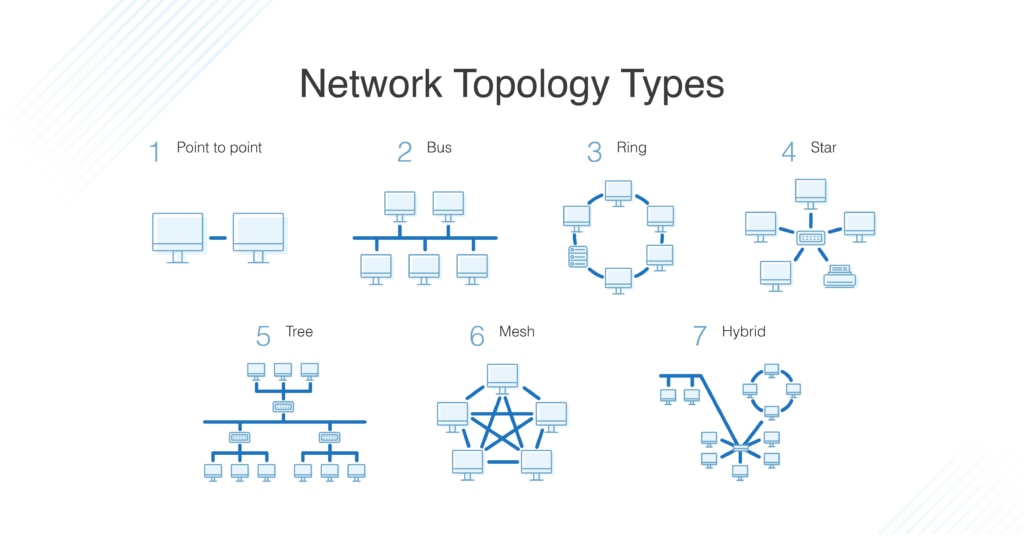
As with most things, theres no right or one-size-fits-all option. With this in mind, Ill walk you through the most common network topology definitions to give you a feel for the advantages and disadvantages of each.
What Is Star Topology?
A star topology, the most common network topology, is laid out so every node in the network is directly connected to one central hub via coaxial, twisted-pair, or fiber-optic cable. Acting as a server, this central node manages data transmissionas information sent from any node on the network has to pass through the central one to reach its destinationand functions as a repeater, which helps prevent data loss.
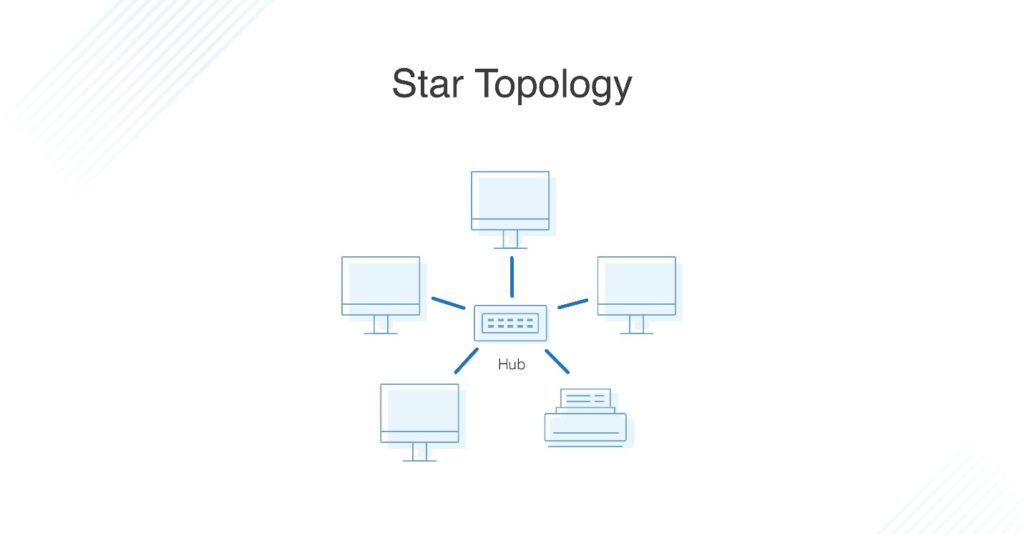
Advantages of Star Topology
Star topologies are common since they allow you to conveniently manage your entire network from a single location. Because each of the nodes is independently connected to the central hub, should one go down, the rest of the network will continue functioning unaffected, making the star topology a stable and secure network layout.
Additionally, devices can be added, removed, and modified without taking the entire network offline.
On the physical side of things, the structure of the star topology uses relatively little cabling to fully connect the network, which allows for both straightforward setup and management over time as the network expands or contracts. The simplicity of the network design makes life easier for administrators, too, because its easy to identify where errors or performance issues are occurring.
Disadvantages of Star Topology
On the flipside, if the central hub goes down, the rest of the network cant function. But if the central hub is properly managed and kept in good health, administrators shouldnt have too many issues.
The overall bandwidth and performance of the network are also limited by the central nodes configurations and technical specifications, making star topologies expensive to set up and operate.
Back to top
What Is Bus Topology?
A bus topology orients all the devices on a network along a single cable running in a single direction from one end of the network to the otherwhich is why its sometimes called a line topology or backbone topology. Data flow on the network also follows the route of the cable, moving in one direction.
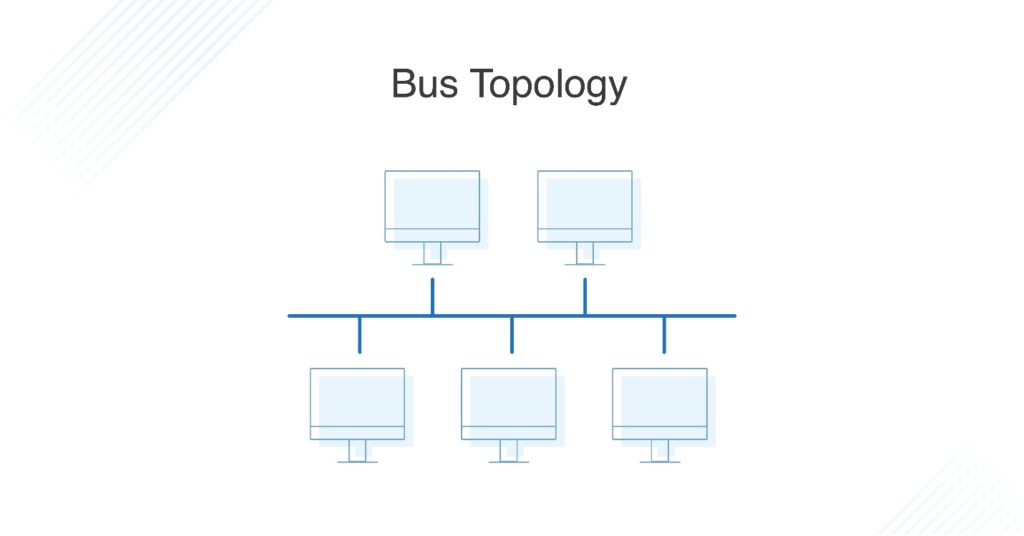
Advantages of Bus Topology
Bus topologies are a good, cost-effective choice for smaller networks because the layout is simple, allowing all devices to be connected via a single coaxial or RJ45 cable. If needed, more nodes can be easily added to the network by joining additional cables.
Disadvantages of Bus Topology
However, because bus topologies use a single cable to transmit data, theyre somewhat vulnerable. If the cable experiences a failure, the whole network goes down, which can be time-consuming and expensive to restore, which can be less of an issue with smaller networks.
Bus topologies are best suited for small networks because theres only so much bandwidth, and every additional node will slow transmission speeds.
Furthermore, data is half-duplex, which means it cant be sent in two opposite directions the same time, so this layout is not the ideal choice for networks with huge amounts of traffic.
Back to top
What Is Ring Topology? Single vs. Dual
Ring topology is where nodes are arranged in a circle (or ring). The data can travel through the ring network in either one direction or both directions, with each device having exactly two neighbors.
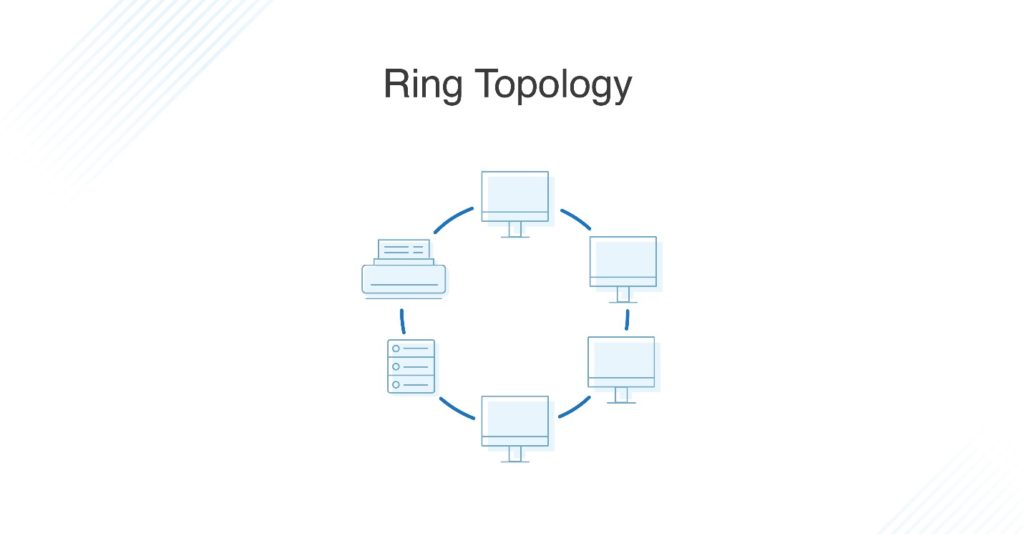
Pros of Ring Topology
Since each device is only connected to the ones on either side, when data is transmitted, the packets also travel along the circle, moving through each of the intermediate nodes until they arrive their destination. If a large network is arranged in a ring topology, repeaters can be used to ensure packets arrive correctly and without data loss.
Only one station on the network is permitted to send data a time, which greatly reduces the risk of packet collisions, making ring topologies efficient transmitting data without errors.
By and large, ring topologies are cost-effective and inexpensive to install, and the intricate point-to-point connectivity of the nodes makes it relatively easy to identify issues or misconfigurations on the network.
Cons of Ring Topology
Even though its popular, a ring topology is still vulnerable to failure without proper network management. Since the flow of data transmission moves unidirectionally between nodes along each ring, if one node goes down, it can take the entire network with it. Thats why its imperative for each of the nodes to be monitored and kept in good health. Nevertheless, even if youre vigilant and attentive to node performance, your network can still be taken down by a transmission line failure.
The question of scalability should also be taken into consideration. In a ring topology, all the devices on the network share bandwidth, so the addition of more devices can contribute to overall communication delays. Network administrators need to be mindful of the devices added to the topology to avoid overburdening the networks resources and capacity.
Additionally, the entire network must be taken offline to reconfigure, add, or remove nodes. And while thats not the end of the world, scheduling downtime for the network can be inconvenient and costly.
What Is Dual-Ring Topology?
A network with ring topology is half-duplex, meaning data can only move in one direction a time. Ring topologies can be made full-duplex by adding a second connection between network nodes, creating a dual ring topology.
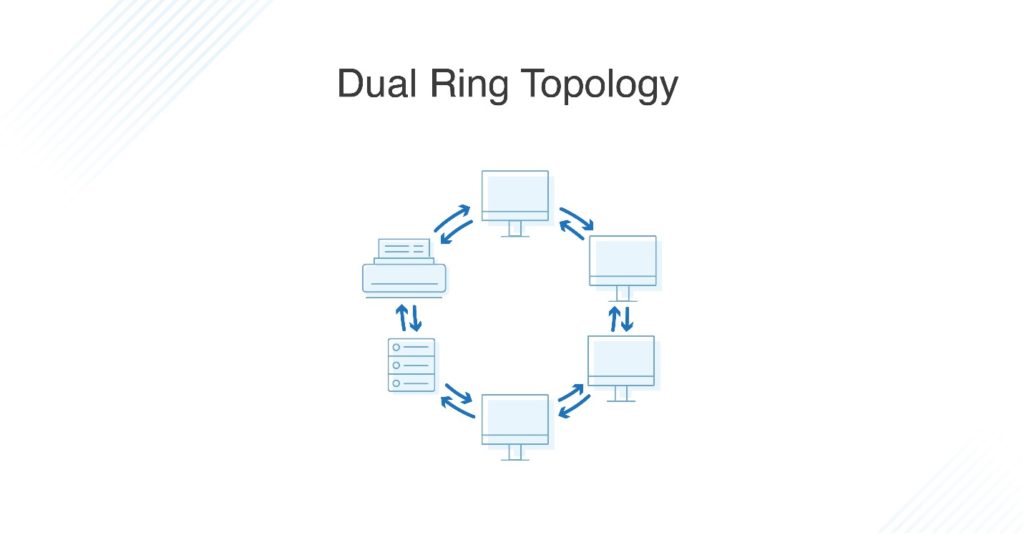
Advantages of Dual-Ring Topology
The primary advantage of dual ring topology is its efficiency: because each node has two connections on either side, information can be sent both clockwise and counterclockwise along the network. The secondary ring included in a dual-ring topology setup can act as a redundant layer and backup, which helps solve for many of the disadvantages of traditional ring topology. Dual ring topologies offer a little extra security, too: if one ring fails within a node, the other ring is still able to send data.
Back to top
What Is Tree Topology?
The tree topology structure gets its name from how the central node functions as a sort of trunk for the network, with nodes extending outward in a branch-like fashion. However, where each node in a star topology is directly connected to the central hub, a tree topology has a parent-child hierarchy to how the nodes are connected. Those connected to the central hub are connected linearly to other nodes, so two connected nodes only share one mutual connection. Because the tree topology structure is both extremely flexible and scalable, its often used for wide area networks to tư vấn many spread-out devices.
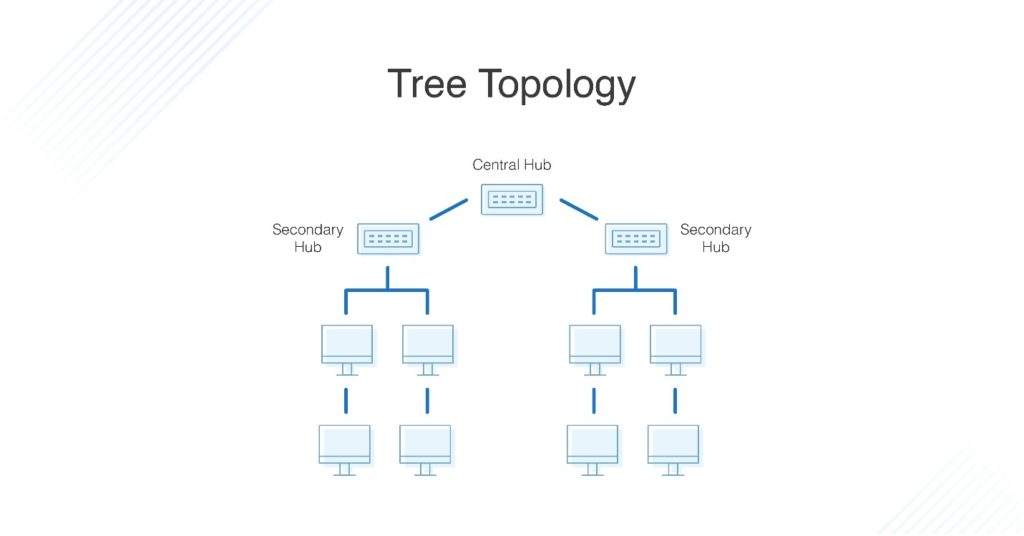
Pros of Tree Topology
Combining elements of the star and bus topologies allows for the easy addition of nodes and network expansion. Troubleshooting errors on the network is also a straightforward process, as each of the branches can be individually assessed for performance issues.
Cons of Tree Topology
As with the star topology, the entire network depends on the health of the root node in a tree topology structure. Should the central hub fail, the various node branches will become disconnected, though connectivity withinbut not betweenbranch systems will remain.
Because of the hierarchical complexity and linear structure of the network layout, adding more nodes to a tree topology can quickly make proper management an unwieldy, not to mention costly, experience. Tree topologies are expensive because of the sheer amount of cabling required to connect each device to the next within the hierarchical layout.
Back to top
What Is Mesh Topology?
A mesh topology is an intricate and elaborate structure of point-to-point connections where the nodes are interconnected. Mesh networks can be full or partial mesh. Partial mesh topologies are mostly interconnected, with a few nodes with only two or three connections, while full-mesh topologies aresurprise!fully interconnected.
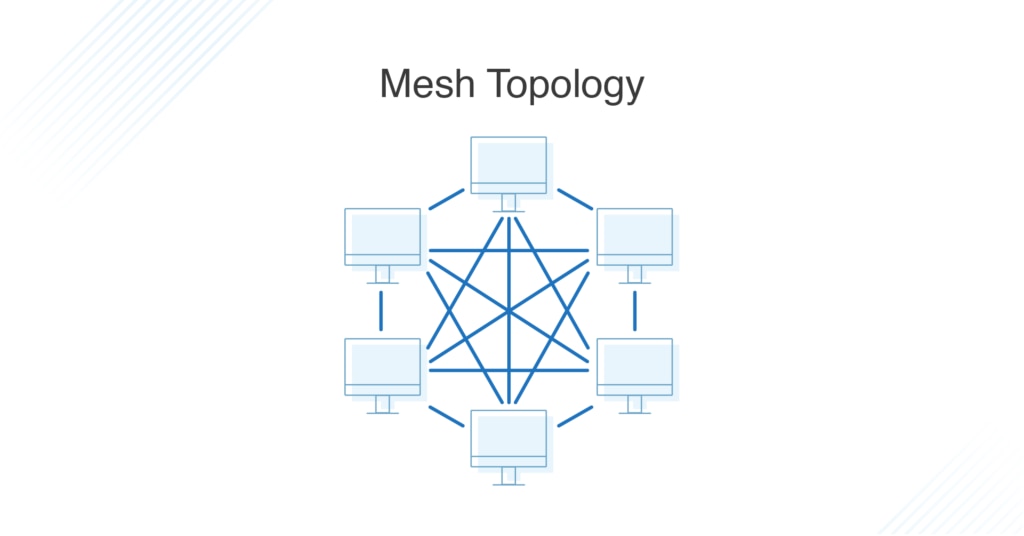
The web-like structure of mesh topologies offers two different methods of data transmission: routing and flooding. When data is routed, the nodes use logic to determine the shortest distance from the source to destination, and when data is flooded, the information is sent to all nodes within the network without the need for routing logic.
Advantages of Mesh Topology
Mesh topologies are reliable and stable, and the complex degree of interconnectivity between nodes makes the network resistant to failure. For instance, no single device going down can bring the network offline.
Disadvantages of Mesh Topology
Mesh topologies are incredibly labor-intensive. Each interconnection between nodes requires a cable and configuration once deployed, so it can also be time-consuming to set up. As with other topology structures, the cost of cabling adds up fast, and to say mesh networks require a lot of cabling is an understatement.
Back to top
What Is Hybrid Topology?
Hybrid topologies combine two or more different topology structuresthe tree topology is a good example, integrating the bus and star layouts. Hybrid structures are most commonly found in larger companies where individual departments have personalized network topologies adapted to suit their needs and network usage.
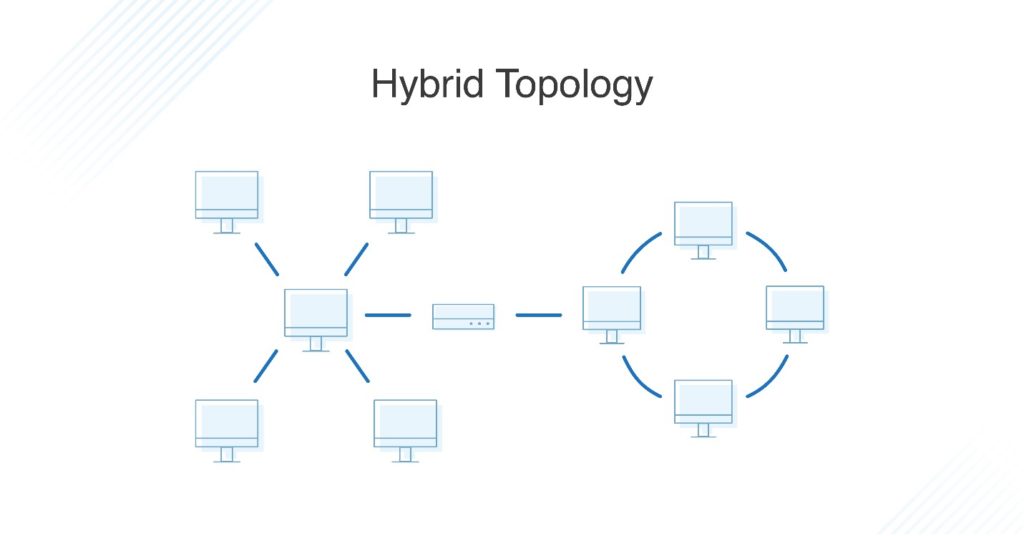
Advantages of Hybrid Topology
The main advantage of hybrid structures is the degree of flexibility they provide, as there are few limitations on the network structure itself that a hybrid setup cant accommodate.
Disadvantages of Hybrid Topology
However, each type of network topology comes with its own disadvantages, and as a network grows in complexity, so too does the experience and know-how required on the part of the admins to keep everything functioning optimally. Theres also the monetary cost to consider when creating a hybrid network topology.
Back to top
Which Topology Is Best for Your Network?
No network topology is perfect, or even inherently better than the others, so determining the right structure for your business will depend on the needs and size of your network. Here are the key elements to consider:
Cable Length
Generally, the more cable involved in network topology, the more work itll require to set up. The bus and star topologies are on the simpler side of things, both being fairly lightweight, while mesh networks are much more cable- and labor-intensive.
Cable Type
The second point to consider is the type of cable youll install. Coaxial and twisted-pair cables both use insulated copper or copper-based wiring, while fiber-optic cables are made from thin and pliable plastic or glass tubes. Twisted-pair cables are cost-effective but have less bandwidth than coaxial cables. Fiber-optic cables are high performing and can transmit data far faster than twisted-pair or coaxial cables, but they also tend to be far more expensive to install, because they require additional components like optical receivers. So, as with your choice of network topology, the wiring you select depends on the needs of your network, including which applications youll be running, the transmission distance, and desired performance.
Cost
As Ive mentioned, the installation cost is important to account for, as the more complex network topologies will require more time and funding to set up. This can be compounded if youre combining different elements, such as connecting a more complex network structure via more expensive cables (though using fiber-optic cables in a mesh network is overdoing it, if you ask me, because of how interconnected the topology is). Determining the right topology for your needs, then, is a matter of striking the right balance between installation and operating costs and the level of performance you require from the network.
Scalability
The last element to consider is scalability. If you anticipate your company and network expandingor if youd like it to be able toitll save you time and hassle down the line to use an easily modifiable network topology. Star topologies are so common because they allow you to add, remove, and alter nodes with minimal disruption to the rest of the network. Ring networks, on the other hand, have to be taken entirely offline for any changes to be made to any of the nodes.
How to Map Network Topology
When youre starting to design a network, topology diagrams come in handy. They allow you to see how the information will move across the network, which, in turn, allows you to predict potential choke points. Visual representation makes it easier to create a streamlined and efficient network design, while also acting as a good reference point if you find yourself needing to troubleshoot errors.
A topology diagram is also essential for having a comprehensive understanding of your networks functionality. In addition to assisting with the troubleshooting process, the birds-eye view provided by a topology diagram can help you visually identify the pieces of the infrastructure your network is lacking, or which nodes need monitoring, upgrading, or replacing.
The good news is you dont have to do it manually: you can easily create a map of your network topology with tools.
Back to top
What Tools Help Manage and Monitor Networks?
There are a few network topology mapping products on the market. One of the more common ones is Microsoft Visio, which lets you draw your network by adding different nodes and devices to a canvas-like interface. While this can work for smaller networks, drawing each additional node quickly becomes unwieldy if youre working with a multitude of devices and topologies spread across an entire company. Other options, like Lucidchart and LibreOffice Draw, are either không lấy phí or offer không lấy phí trials, and while theyre viable options, especially if the cost is a concern, they dont come with a full set of premium network mapping tools to make managing a network easier and less time-consuming.
Due to variations in network topology and the different ways networks can behaveincluding their unique security issues, pressure points, and management challengesits often useful to automate configuration and management tasks using network software.
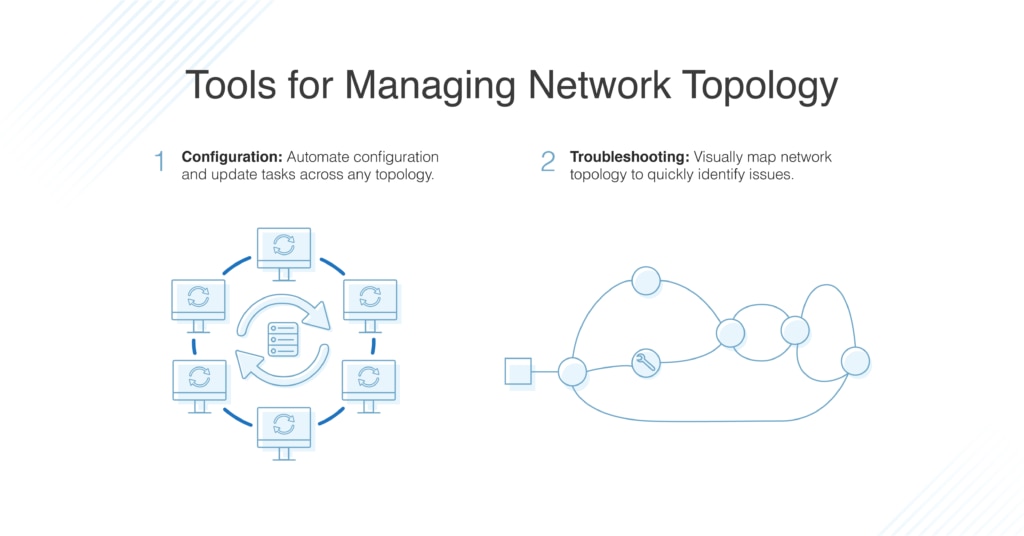
Network Configuration
First, consider using a network configuration management tool. This kind of tool can help you configure your network correctly and automate repetitive tasks to take the pressure off the network administrator. As your organization or network grows, the network topology may become more layered or more complex, and it can become harder to deploy configurations across the entire network with certainty. However, with configuration management tools, the complicated network topology is no issue: tools can usually auto-detect each node on the network, allowing you to deploy standard configurations that may be required for compliance reasons, or flag any configurations outside what is expected.
Network configuration management tools can also highlight vulnerabilities, so you can correct these issues and keep your network more secure. Finally, these kinds of tools should also display the lifecycle of the devices on your network, alerting you to devices coming to their end-of-service or end-of-life points, so you can replace them before problems begin to arise.
Network Performance Troubleshooting
You should use network management software to track overall performance. A performance manager can keep track of network issues, outages, and performance issues. A performance management tool will also have the functionality to set network performance baselines and establish a clear picture of how your network typically behaves when healthy. Then, by setting alerts when your network performs unexpectedly or outside of these baselines, you can quickly track, pinpoint, and troubleshoot issues.
With complex network topologies, it may be hard to figure out exactly which part of the network is having issues. Some performance managers will create a visual display of your network topology, so you can see the entire network in a one-map overview. This can show you how your network is laid out, bring your attention to changes in the topology, and flag where problems are arising. To get started understanding your network topology, you can try a tool like Network Topology Mapper không lấy phí for 14 days. This tool automatically discovers and generates detailed topology maps of your network and can create multiple map types without having to rescan your network every time.
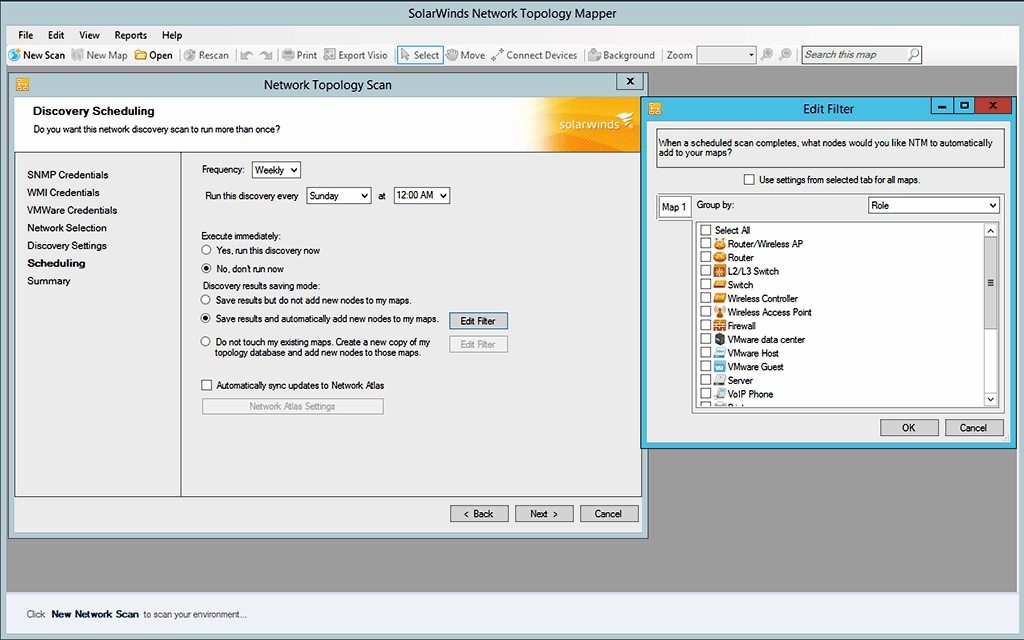
Thats one reason I really like SolarWinds Network Topology Mapper (NTM). No matter the size of your network, it can not only automatically discover all the devices and create a diagram of your network topology for you, but also populate the map with industry-specific icons for easy visual differentiation. In addition to the auto-discovery feature, the software offers an intuitive network wizard so you can drag and drop nodes and node groups (which you can also customize). Visualizing the various connections between nodes in a single map or diagram can be cumbersome, especially if youre working with an expansive wide area network, but the interface in NTM lets you sort through different layers of connections, depending on the level youre trying to inspect.
You can configure NTM to periodically rescan your network to keep your diagrams up to date. It integrates easily with other programs, and it offers a robust reporting system so you can track metrics, from device inventory to network performance, all while helping keep you PCI compliant.
Topology Mapping for Managed Services Providers
Topology mapping isnt just important for managing a single network. Its also a key aspect of managed services providers (MSPs) essential dutiesfor hundreds or even thousands of different customers across multiple networks.
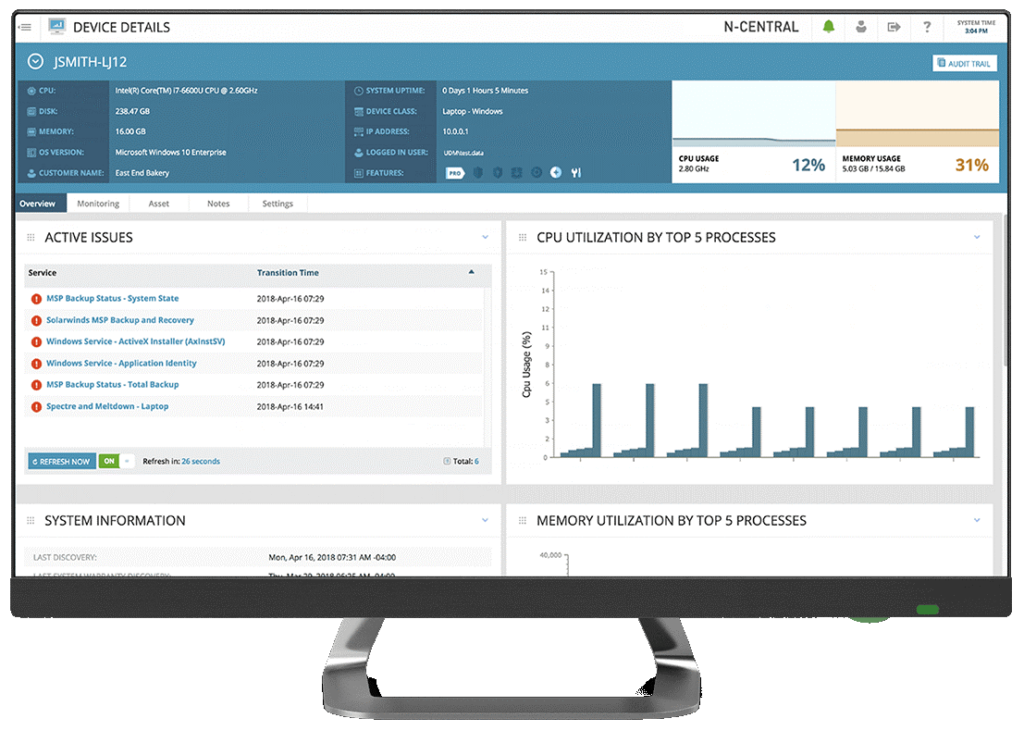
Due to the specific needs of MSPs, it often isnt enough to use the same tool you might use for your personal or company network. Its worth noting that another SolarWinds MSP (currently N-able) product, N-central®, has a specialized tool for this use case.
The N-central network topology mapping solution enables you to perform in-depth assessments of the networks you manage. You can perform on-demand and scheduled scans, as well as get access to detailed data represented in a clear, visual way.
What to Know About Network Topology Today
The best advice I can give regarding network topology is that you should be deeply familiar with the needs and usage requirements of your network. The total number of nodes on the network is one of the primary considerations to account for, as this will dictate whether its feasible to use a simpler topology, or whether youll have to make the investment in a more complicated network structure.
As I mentioned earlier, no one topology is best. Each offers its own set of perks and drawbacks, depending on the network environment youre working with or attempting to set up. For this reason, I would avoid jumping to immediate conclusions about any of the network topologies based solely on the descriptions here. Before deciding, try using a network topology mapping tool to sketch the layout youre thinking about using. Network Topology Mapper, my personal favorite, lets you plot the entire structure of your network in a way thats both easy to use and easy to parse, and it offers a 14-day không lấy phí trial.
Reply
7
0
Chia sẻ
Share Link Tải Office network topology miễn phí
Bạn vừa đọc Post Với Một số hướng dẫn một cách rõ ràng hơn về Video Office network topology tiên tiến và phát triển nhất và Share Link Down Office network topology Free.

Giải đáp vướng mắc về Office network topology
Nếu sau khi đọc nội dung bài viết Office network topology vẫn chưa hiểu thì hoàn toàn có thể lại Comment ở cuối bài để Tác giả lý giải và hướng dẫn lại nha
#Office #network #topology